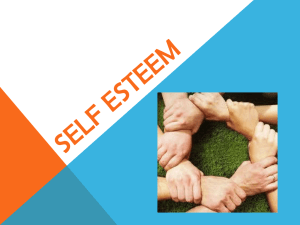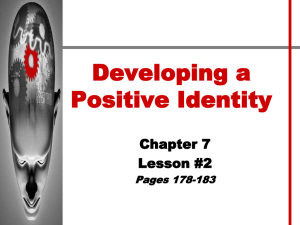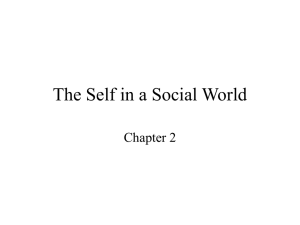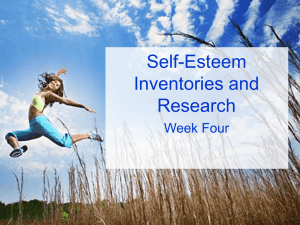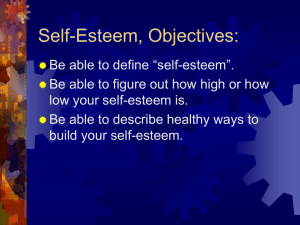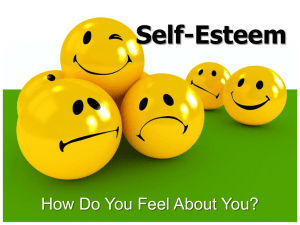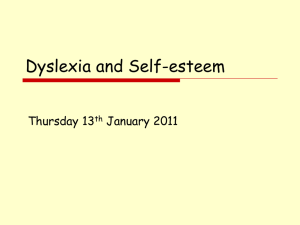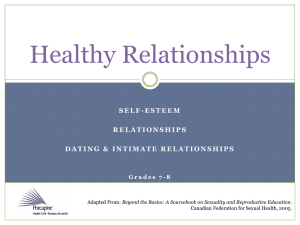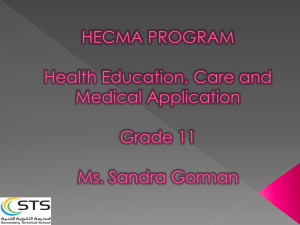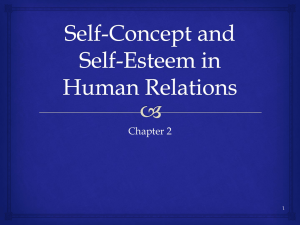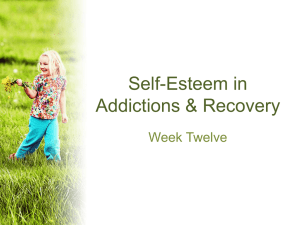Dyslexia, ADHD and SE
advertisement
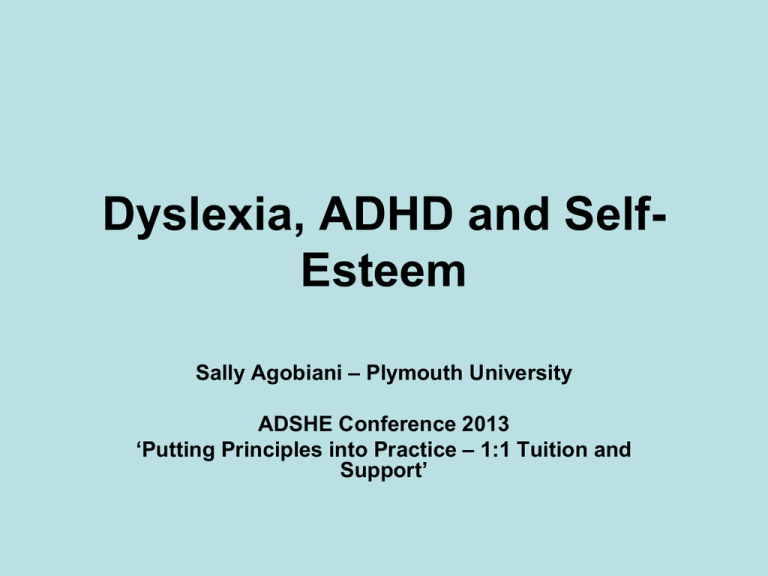
Dyslexia, ADHD and SelfEsteem Sally Agobiani – Plymouth University ADSHE Conference 2013 ‘Putting Principles into Practice – 1:1 Tuition and Support’ Herman Hesse Steppenwolf ‘No self…is a unity. Rather it is an extremely diverse world, a miniature firmament, a chaos of different forms, different states and stages of development, different legacies and potentialities.’ Workshop Path 1. Research • Coexistence – ADHD & dyslexia • Self-esteem and college adjustment 2. What is self-esteem? 3. Improving self-esteem ADHD Screening Attention-Deficit Hyperactivity Disorder: A Clinical Workbook (2nd ed) by R. A. Barkley and K.R. Murphy Current Symptoms Scale: Self-Report Form Scoring: 1.Symptom Count Compared to DSM-IV Criteria 2.Symptom Count Relative to Adult Norms 3.Summary Scores Compared to Adult Norms Self-Esteem Screening The Self Image Profile for Adults (SIP-AD) by R.J. Butler and S.L. Gasson Self-report scale for self-image and self-esteem. 0 – 6 Likert scale Multi-Dimensional Structure of Self 1. Outlook 2. Consideration of others 3. Social 4. Physical 5. Competence 6. Moral High score : high self-image High score : low self-esteem University Adjustment SACQ Student Adaptation to College Questionnaire by R.W. Baker and B. Siryk 67 item self-report questionnaire measuring college/university adjustment Subscales: 1.Academic 2.Social 3.Personal-Emotional 4.Attachment Why a lower SE? ‘The dominant paradigm is still one of ‘in-person’ weakness rather than one which shows quite clearly that it is the specific values which are attached to particular concepts and standards of literacy and numeracy which largely shape the way in which dyslexia is perceived and experienced.’ (Herrington & Hunter-Carsh, 2001, p. 114) Healthy Self-Esteem ‘ a quiet pleasure in being one’s self’ (Rogers, 1961, p.87) ‘But does anything take more courage – is anything more challenging and sometimes frightening – than to live by our own mind, judgement, and values? Is not self-esteem a summons to the hero within us?’ (Branden, 1994) ‘Being comfortable with yourself means that you are not forever thinking about and worrying about yourself, always prey to difficult and unpleasant emotions. Being comfortable with other people means that you are not afraid of others but can enjoy their company. There’s no longer a barrier between you and other people. No longer burdened with the sense of your own inadequacies, you cease to see the world as a cold, evil, disappointing place and instead become aware of the world’s infinite possibilities’ (Rowe, 2006, p. 2) ‘..the disposition to experience oneself as competent to cope with the basic challenges of life and as worthy of happiness’ (Branden, 1994, p. ) Poor v. Healthy • • • • • • • • Irrationality Blindness to reality Rigidity Fear of the new and unfamiliar Inappropriate conformity or inappropriate rebelliousness Defensiveness Over compliant or over controlling behaviour Fear of others • • • • • • • • Rationality Realism Intuitiveness Creativity Independence Flexibility Ability to manage change Willingness to admit and correct mistakes • Benevolence • Cooperativeness Since the feeling of worth has been learned, it can be unlearned, and something new can be learned in its place. The possibility for this learning lasts from birth to death, so it is never too late. (Satir 1991, p. 27) The role of the tutor can be seen to be manifold as it ‘involves a mix of teaching, counselling [and] advocacy’ (Hunter-Carsch & Herrington, 2001, p. 173)…. However, she goes further in referring to the student’s ‘Global Self Concept’ where non-academic factors, such as social, emotional, physical and special skills are also regarded as being essential considerations when the progress and retention of learners with dyslexia is concerned. (Severs, 2008, p. 1) (ADSHE 2009, p. 7) How? 1. Know what self-esteem is 2. Improve our own self-esteem 3. Integrate activities into our sessions Self-Fulfilling Prophecies Expectations of what is appropriate and possible Realities confirm and strengthen original beliefs Actions A person’s image of the future may be a better predictor of future attainment than his past performance E.P. Torrance (1925 – 2003) If we all did the things we are capable of, we would astound ourselves T.A. Edison (1847 – 1931) But would we? We don’t see things as they are, we see them as we are Anais Nin (1902 – 1977) Everything we hear is an opinion, not a fact. Everything we see is a perspective, not the truth Marcus Aurelius (121 – 180 A.D.) The Six Pillars of Self-Esteem The practice of… 1.Living consciously 2.Self-acceptance 3.Self-responsibility 4.Self-assertiveness 5.Living purposefully 6.Personal integrity 1. Living Consciously The practice of being aware of what you are doing while doing it, i.e. the practice of mindfulness. Implicit in this is self responsibility •Awareness of position relative to goals •Adjustments after feedback •Persevering in understanding/acquiring a skill in spite of difficulties. Conscious decision to discontinue •Willingness to see and correct mistakes •Seeking to expand awareness - a commitment to learning /growth 2. Self-acceptance The practice of owning your thoughts, emotions and behaviour; of being kind to yourself with respect to them; and of being “for” yourself •Knowing strengths; recognizing areas may want to improve •Accepting mistakes are natural and learning from them •Knowing you are doing the best you can with the knowledge and skills currently available •Accepting our bodies, our emotions, our thoughts, our actions as our own and not alien The worst loneliness is not to be comfortable with yourself Mark Twain 3. Self-responsibility I am responsible for • the achievement of my goals • my choices and actions • the level of consciousness I bring to my work/relationships • my behaviour with other people • how I prioritise my time • my personal happiness • choosing the values by which I live • raising my self-esteem No one is coming - no one is coming to save me, no one is coming to make life right for me, no one is coming to solve my problems. If I don't do something, nothing is going to get better 4. Self-assertiveness The practice of treating your needs and interests with respect and of expressing them in appropriate ways. the willingness to stand up for myself to be who I am openly to treat myself with respect in all encounters X inappropriate aggressiveness X pushing to the front of the line Xupholding my own rights while being blind or indifferent to everyone else’s. My life does not belong to others and I am not here on earth to live up to someone else’s expectations. 5. Living Purposefully • Taking responsibility for formulating goals and purposes consciously • Being concerned to identify the actions necessary to achieve your goals • Monitoring behaviour to check that it is in alignment with your goals • Paying attention to the outcomes of your actions, to know whether they are leading where you want to go 6. Personal Integrity • The integration of convictions and behaviour • If we behave in ways we consider to be inappropriate, we lose respect for ourselves • Involves questions – am I honest, reliable, trustworthy, fair? • Matching of words/thoughts and behaviour Pride: Vice or Virtue? Self-esteem contemplates what needs to be done and says, ‘I can’. Pride contemplates what has been accomplished and says, ‘I did’. What are the 3 things you are most proud of? Self-Esteem and Study Skills Raising SE follows the same principle as physical exercise. Difficult Enjoyable How can I support and encourage the six pillars and not undermine them? The practice of… 1.Living consciously 2.Self-acceptance 3.Self-responsibility 4.Self-assertiveness 5.Living purposefully 6.Personal integrity References ADSHE, 2009. Guidelines for Quality Assurance in Specialist Support for Students with SpLDs in Higher Education BAKER, R.W. & SIRYK, B. 1999. SACQ Student Adaptation to College Questionnaire Manual LA: Western Psychological Services BARKLEY, R.A. & MURPHY K.R. 1998 A Clinical Workbook: Attention Deficit Hyperactivity Disorder. 2nd edn. New York: The Guilford Press BRANDEN, N. 1994. The Six Pillars of Self-Esteem New York: Bantam BUTLER, R.J. & GASSON, S.L. 2004. The Self Image Profile for Adults SIP- AD Manual London: Pearson HERRINGTON, M. & HUNTER-CARSCH M. (2001) A Social Interactive Model of Specific Learning Difficulties e.g. Dyslexia. In: Hunter-Carsch, M. (ed) Dyslexia: A Psychosocial Perspective. London:Whurr ROGERS, C. 1961 On Becoming a Person: A Therapist’s View of Psychology London: Constable ROWE, D. 2006. Dorothy Rowe’s Guide to Life London: Harper Perennial SATIR, V. 1991 Peoplemaking London: Souvenir Press
